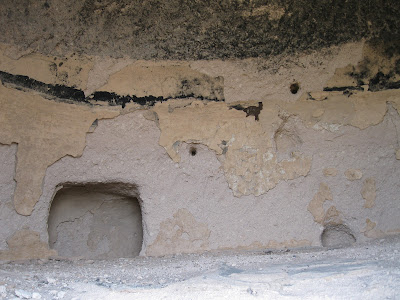The Puye Cliff Dwellings and Mesa Top are located a few miles southwest of Espanola along Route 30 in northwest New Mexico. They are a complex of Ancestral Pueblo ruins that are considered to be an ancestral home of the present day Santa Clara Pueblo. The Santa Clara Tribe has a Welcome Center on Route 30 where tickets are purchased. Then, it is a seven mile scenic drive to the cliffs.
All the hikes here are guided with tours beginning on the hour. In 2012, the full tour to the cliffs and mesa top costs $35. The price probably keeps the tour groups comfortably small. I arrived in time for the 10:00 AM tour and was the only person hiking along with the guide.
The first trail segment is paved and climbs to a first level of cliffs and then moves to the right. Along this level there are many cavities in the soft volcanic tuff that have been enlarged and carved out into living spaces. This first level of dwelling extends for 1 mile, though the tour doesn't visit the full extent. There is more of an opportunity here to view the interior details of these cavities than at most of the other sites in the area.
Some of the cavities have remnants of plaster. There are small storage areas and ventilation holes. The cavities formerly had stone structures in front of them. An example of a stone front structure has been reconstructed and is visible when the tour first arrives at the upper trail. The reconstructed Terrace House appears to have partially collapsed in the spring of 2012. My tour only viewed the reconstruction from a distance.
The holes in the cliff face that held the roof beams are visible. In many places there are petroglyphs. Some of the petroglyphs are thought to be sun calendars and identification symbols of the family that lived there.
It is surprising that, at the right end of the trail, there is a climb up to a second level of cliff dwellings that sits above the lower level. The second level extends for about 2100 feet. The guide said that the rock is a little more porous on the higher level and the upper dwellings weren't as desirable.
The whole complex of cliff dwellings is thought to be winter residences. The rock absorbs the winter sunlight and provides more warmth than the more exposed mesa top. The farming activity here was on the canyon floor below and not on the mesa top.
There are several examples of stairways that the inhabitants carved into the soft rock. These stairways also acted as water drainage channels. The water was collected at the bottom of the cliffs for use.
I was surprised how many artifacts were collected into small displays along the trail. There are several styles of pottery visible and many stone tools including some of the very sharp obsidian. The cliff dwellings segment of the total tour lasts about 1:00 hour. From the second level of cliffs it is not very much higher to climb to the mesa top. There is a van available, if needed, to drive visitors to the mesa top for that portion of the tour.






